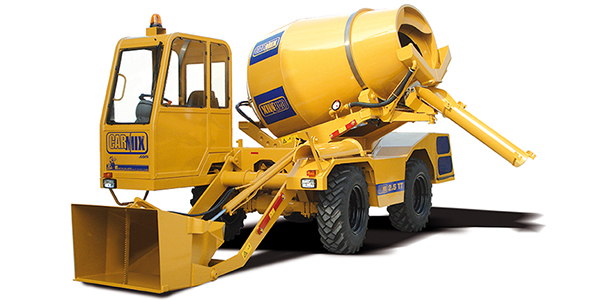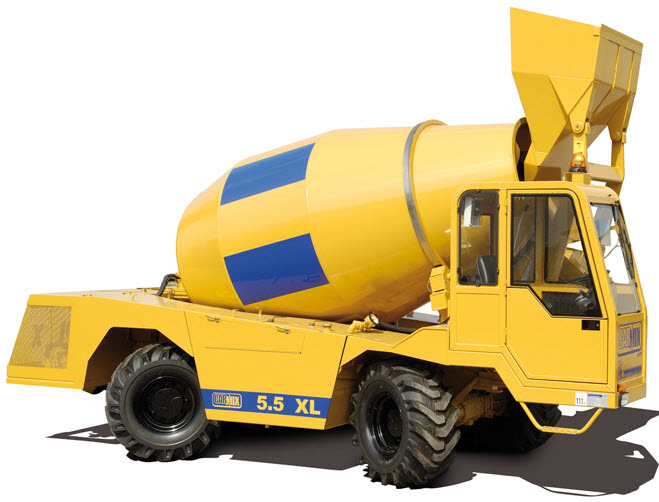
Self-loading concrete mixers are invaluable assets on construction sites, combining the functions of a loader, mixer, and transporter into a single efficient machine. To ensure these machines remain in top condition and deliver consistent performance, regular maintenance is crucial. Proper upkeep not only extends the lifespan of the equipment but also enhances safety and productivity. Here are essential maintenance tips for self-loading concrete mixers:
- Daily Checks and Inspections
Daily checks are vital for the early detection of potential issues. Before starting the mixer, perform a thorough inspection to ensure all components are in good working condition.
Key Areas to Inspect:
- Hydraulic System: Check for any leaks, and ensure the hydraulic oil levels are adequate.
- Engine Oil: Verify the engine oil level and look for any signs of leaks.
- Mixing Drum: Inspect the drum for any cracks or wear, and ensure it rotates smoothly.
- Tires: Check tire pressure and inspect for any damage or excessive wear.
- Brakes and Lights: Ensure all brakes and lights are functioning correctly.

- Regular Lubrication
Lubrication is essential for reducing friction between moving parts, preventing wear and tear, and ensuring smooth operation.
Lubrication Tips:
- Grease Points: Identify all grease points on the mixer and apply the recommended type of grease regularly.
- Hydraulic Components: Use the appropriate hydraulic oil for the system and maintain the correct levels.
- Drum Bearings: Lubricate the drum bearings to prevent seizing and ensure smooth rotation.
- Cleaning the Mixer
Regular cleaning of the mixer is crucial to prevent the buildup of concrete residue, which can affect performance and lead to damage.
Cleaning Steps:
- Mixing Drum: Use a high-pressure water system to clean the inside of the drum after each use. Remove any hardened concrete that might have adhered to the drum walls.
- Exterior: Wash the exterior of the mixer to remove dust, dirt, and concrete splashes.
- Shovel and Loader: Clean the hydraulic shovel and loader arms to ensure they function smoothly without obstruction.
- Scheduled Maintenance
In addition to daily checks, scheduled maintenance should be conducted according to the manufacturer’s recommendations.
Scheduled Maintenance Tasks:
- Oil and Filter Changes: Regularly change the engine oil and hydraulic oil, and replace filters to ensure the system remains clean and efficient.
- Coolant System: Check the coolant levels and inspect the cooling system for leaks or blockages.
- Fuel System: Inspect the fuel lines and filters, and replace them as necessary to prevent fuel contamination.
- Battery: Check the battery terminals for corrosion, and ensure the battery is adequately charged.
- Inspection of Wear Parts
Wear parts, such as the mixing blades and tires, should be regularly inspected and replaced as needed.
Wear Parts to Monitor:
- Mixing Blades: Inspect the blades for wear and replace them if they are worn down to maintain efficient mixing.
- Tires: Regularly check the tire tread depth and replace tires that show signs of excessive wear.
- Hydraulic Hoses: Inspect hoses for any signs of wear or leaks and replace them if necessary.
- Electrical System Maintenance
The electrical system of the mixer, including the control panel and sensors, should be routinely checked to ensure proper operation.
Electrical System Tips:
- Wiring: Inspect all wiring for signs of wear or damage, and ensure connections are secure.
- Control Panel: Test the control panel functions and ensure all buttons and switches are responsive.
- Sensors: Verify that all sensors, such as the electronic weighing system, are functioning correctly and providing accurate readings.
- Training and Safety
Proper training for operators is essential to ensure they understand how to use and maintain the equipment correctly.
Training Tips:
- Operator Training: Ensure all operators receive comprehensive training on the correct use and maintenance of the mixer.
- Safety Protocols: Emphasize the importance of following safety protocols, such as wearing protective gear and adhering to operational guidelines.
- Maintenance Logs: Keep detailed maintenance logs to track inspections, repairs, and replacements, ensuring no maintenance task is overlooked.
FAQs on Maintenance of Self-Loading Concrete Mixers
A1: Hydraulic oil should typically be changed every 1,000 to 2,000 hours of operation, but always follow the manufacturer's specific recommendations.
A2: Use a high-pressure water system and specialized concrete removal chemicals if necessary. Regular cleaning after each use can prevent hardening.
A3: Regularly calibrate the weighing system according to the manufacturer's guidelines and check for any sensor issues that might affect accuracy.
A4: Immediately stop the machine, identify the source of the leak, and replace the damaged hose or seal. Running the machine with a hydraulic leak can cause significant damage.
A5: Regularly change the engine oil and filters, use high-quality fuel, and ensure the cooling system is functioning properly to prevent overheating.
A6: Use the appropriate grade of oil for cold weather, keep the battery charged, and allow the engine to warm up before operation. Additionally, clean the mixer thoroughly to prevent ice formation.
Conclusion
Regular maintenance of self-loading concrete mixers is crucial for ensuring their longevity, reliability, and optimal performance on construction sites. By following these maintenance tips, operators can keep their equipment in top condition, minimize downtime, and maximize productivity. Investing time and resources into proper maintenance practices will ultimately lead to cost savings and more efficient construction operations.
Recent Articles
- Market Growth and Future Trends in Self-Loading Concrete Mixers for the Construction Industry
- How Self-Loading Concrete Mixers Reduce Labour Costs and Increase Productivity?
- Comparing Self-Loading Concrete Mixers vs. Traditional Concrete Mixing Methods
- The Role of Self-Loading Concrete Mixers in Modern Construction
- Self-Loading Concrete Mixer Machines for Infrastructure Development Projects
Copyright © 2025, Apollo Carmix Equipments Private Limited (ACEPL), All rights are reserved.
Web Design & SEO by Webmasterindia

